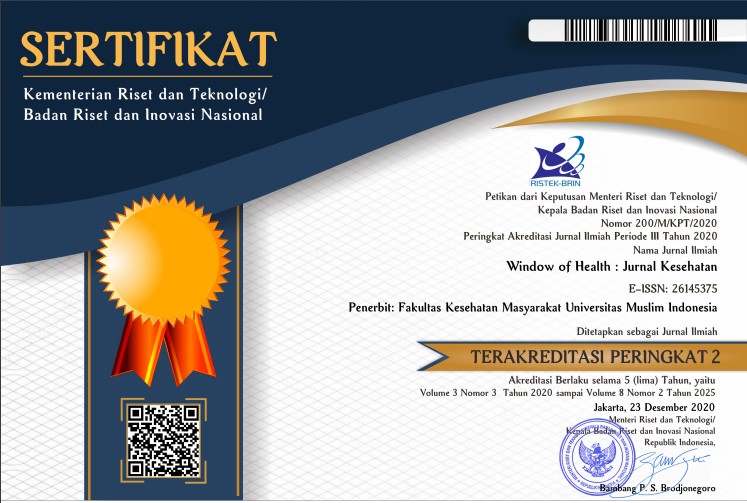Genetic Factors and Purine Consumption as Predictors of Uric Acid in Coastal Communities
Abstract
The incidence of uric acid in the world is estimated at 47.2% which varies in various populations throughout the world. The highest prevalence of uric acid in people aged >15 years, according to districts/cities in Southeast Sulawesi Province, based on doctors' diagnoses, was in North Buton (12.62%). therefore, North Buton District, especially in the working area of the Kulisusu Health Center was chosen as the location of this study. This study aims to determine the predictors of uric acid in people in coastal areas. This study uses a case-control study design. The population in this study consisted of people living in the coastal area of the Kulisusu Health Center, with a total sample of 106 (53 cases and 53 controls). Sampling using a simple random sampling technique. Data was collected using a questionnaire, and the data that had been collected was analyzed statistically using the chi-square test at a 95% confidence level (α = 0.05) which aims to analyze predictors of gout. The results showed that genetic factors had a value (p=0.004; OR=3.559; CI = 1.483-8.539) and purine consumption patterns had a value (p=0.02; OR=3.103; CI=1.162-8.288). It can be concluded that genetic factors and purine consumption patterns are predictors or risk factors for gout in coastal communities in the working area of the Kulisusu Health Center. Coastal communities should limit foods that contain high purines, such as shellfish and meat, especially for those who have a family history of uric acid.
References
2. Chen PE, Liu CY, Chien WH, Chien CW, Tung TH. Effectiveness of Cherries in Reducing Uric Acid and Gout: A Systematic Review. Evidence-based Complement Altern Med. 2019;2019. doi:10.1155/2019/9896757
3. Boštjan Jakše , Barbara Jakše MP and JP. Uric Acid and Plant-Based Nutrition. Nutrient. 2019;11(8):1-15. doi:https://doi.org/10.3390/nu11081736
4. Sa’pang M, Sitoayu L, Rumana NA. Evaluasi Kualitas Diet pada Penderita Diabetes Melitus Tipe II di Jakarta Barat Article history : Accepted 13 November 2020 Address : Available online 25 Januari 2021 Email : Phone : penanganan medis berupa pengaturan diet , pola hidup yang teratur serta. Wind Heal. 2021;04(01):15-22. https://jurnal.fkmumi.ac.id/index.php/woh/article/view/430/139
5. Masriadi, Idrus HH, Baharuddin A. Determinan Epidemiologi Kejadian Hipertensi Kehamilan. Fak Kesehat Masy Univ Muslim Indones. 2022;5(2):592-601. https://jurnal.fkmumi.ac.id/index.php/woh/article/view/47/10
6. FitzGerald JD, Dalbeth N, Mikuls T, et al. 2020 American College of Rheumatology Guideline for the Management of Gout. Arthritis Care Res. 2020;72(6):744-760. doi:10.1002/acr.24180
7. Kemenkes RI. Hasil Utama Riset Kesehata Dasar (RISKESDAS). J Phys A Math Theor. 2018;44(8):1-200. doi:10.1088/1751-8113/44/8/085201
8. Kemenkes RI. Laporan Riskesdas 2018 Provinsi Sulawesi Tenggara I. Lembaga Penerbit Badan Pengembangan Penelitian Kesehatan; 2018. https://ejournal2.litbang.kemkes.go.id/index.php/lpb/article/view/3791
9. Dinas Kesehatan Kabuapten Buton Utara. Profil Dinas Kesehatan Kabupaten Buton Utara Tahun 2020.; 2021.
10. Puskesmas Kulisusu. Profil Puskesmas Kulisusu Tahun 2021. Puskesmas Kulisusu; 2022.
11. Dewi FA, Afridah W. Pola Makan Lansia Penderita Asam Urat Di Posyandu Lansia Kelurahan Wonokromo Surabaya. J Heal Sci. 2018;7(1). doi:10.33086/jhs.v7i1.491
12. Hardianti DMI. Penatalaksanaan Gout Arthritis dan Hipertensi Grade I pada Wanita Lansia Obesitas melalui Pendekatan Dokter Keluarga. Medula. 2020;10(Vol 10 No 1 (2020): Medula):188-192. http://www.journalofmedula.com/index.php/medula/article/view/51/73
13. Delita Septia Rosdiana AK& CMD. Pengetahuan Asam Urat, Asupan Purin Dan Status Gizi Terhadap Kejadian Hiperurisemia Pada Masyarakat Perdesaan. Media Pendidikan, Gizi, dan Kuliner. 2018;7(2):1-11.
14. Rivera-Paredez B, Macías-Kauffer L, Fernandez-Lopez JC, et al. Influence of genetic and non-genetic risk factors for serum uric acid levels and hyperuricemia in mexicans. Nutrients. 2019;11(6):1-19. doi:10.3390/nu11061336
15. Nasir. A MA& IM. Buku Ajar Metodologi Penelitian Kesehatan Konsep Pembuatan Karya Tulis Dan Thesis Untuk Mahasiswa Kesehatan. 2nd ed. Nuha Medika; 2015.
16. Irmawartini & Nurhaedah. Bahan Ajar Kesehatan Lingkungan Metodologi Penelitian. 1st ed. PPSDMK Kemenkes RI; 2017. http://bppsdmk.kemkes.go.id/pusdiksdmk/wp-content/uploads/2017/11/Daftar-isi-Metodologi-Penelitian_k1_restu.pdf
17. Major, T.J., Dalbeth, N., Stahl EA et al. An Update on the Genetics of Hyperuricaemia and Gout. Nat Rev Rheumatol. 2018;1(14):341–353. doi:https://doi.org/10.1038/s41584-018-0004-x
18. Zhang Y, Yang R, Dove A, et al. Healthy lifestyle counteracts the risk effect of genetic factors on incident gout: a large population-based longitudinal study. BMC Med. 2022;20(1):1-12. doi:10.1186/s12916-022-02341-0
19. Magfira N, Adnani H. Hubungan Aktivitas Fisik Dan Riwayat Genetik Dengan Kadar Asam Urat Di Posyandu Cinta Lansia. J Ilmu Keperawatan dan Kebidanan. 2021;12(2):396. doi:10.26751/jikk.v12i2.1033
20. Zhang Y, Chen C, Choi H, et al. Purine-Rich Foods Intake and Recurrent Gout Attacks. Ann Rheum Dis. 2012;71(9):1448-1453. doi:10.1136/annrheumdis-2011-201215
21. Eyal Kedar PAS. A Perspective on Diet and Gout. Adv Chronic Kidney Dis. 2012;16(6):392-397. doi:https://doi.org/10.1053/j.ackd.2012.07.011
Copyright (c) 2023 Irma

This work is licensed under a Creative Commons Attribution-NonCommercial-ShareAlike 4.0 International License.








